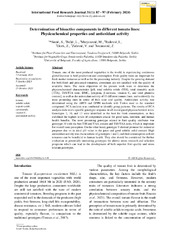Приказ основних података о документу
Determination of bioactive components in different tomato lines: Physicochemical properties and antioxidant activity
| dc.creator | Savić, Slađana | |
| dc.creator | Belić, Lela | |
| dc.creator | Marjanović, Milena | |
| dc.creator | Radović, Ivana | |
| dc.creator | Girek, Zdenka | |
| dc.creator | Zečević, Veselinka | |
| dc.creator | Jovanović, Zorica | |
| dc.date.accessioned | 2024-03-19T19:34:49Z | |
| dc.date.available | 2024-03-19T19:34:49Z | |
| dc.date.issued | 2024 | |
| dc.identifier.issn | 1985-4668 | |
| dc.identifier.uri | http://aspace.agrif.bg.ac.rs/handle/123456789/6886 | |
| dc.identifier.uri | https://enauka.gov.rs/handle/123456789/897651 | |
| dc.identifier.uri | http://RIVeC.institut-palanka.rs/handle/123456789/856 | |
| dc.identifier.uri | https://plantarum.izbis.bg.ac.rs/handle/123456789/1235 | |
| dc.description.abstract | Tomato, one of the most produced vegetables in the world, is experiencing continuous global increase in both production and consumption. Fruit quality traits are important for fresh market tomatoes as well as for the processing industry. Despite the growing demand for both fresh and processed tomatoes, consumers are not satisfied with the quality of available fruits. The main objectives of the present work were to determine the physicochemical characteristics [pH, total soluble solids (TSS), total titratable acids (TTA), TSS/TTA ratio, DMC, lycopene, β-carotene, vitamin C, and total phenolic content], as well as the antioxidant activity of 13 different tomato lines, and to identify the most promising ones in terms of fruit taste and quality. Antioxidant activity was determined using the ABTS and DPPH methods with Trolox used as the standard compound. PCA analysis was conducted to identify group patterns. The results of PCA analysis indicated a specific genotypic response in all investigated physicochemical traits. Genotypes 2, 10, and 13 were identified as the best for fresh consumption, as they exhibited the highest levels of compounds crucial for good taste, nutrition, and human health benefits. The most promising genotype related to fruit quality attributes was genotype 10 with the best TSS and TAA content and TSS/TAA ratio, which is important for overall taste perception. On the other hand, genotype 9 showed promise for industrial purposes due to its ideal pH value in the juice and good soluble solid content. High antioxidant activity was characteristic of genotypes 1 and 2, and their consumption as fresh tomatoes can be beneficial to human health. They also should be considered for further evaluation as potentially interesting genotypes for abiotic stress research and selection programs which can lead to the development of both superior fruit quality and stress tolerant genotypes. | sr |
| dc.language.iso | en | sr |
| dc.publisher | University Putra Malaysia : Faculty of Food Science and Technology | sr |
| dc.relation | info:eu-repo/grantAgreement/MESTD/inst-2020/200116/RS// | sr |
| dc.relation | info:eu-repo/grantAgreement/MESTD/inst-2020/200216/RS// | sr |
| dc.relation | info:eu-repo/grantAgreement/MESTD/inst-2020/200010/RS// | sr |
| dc.rights | openAccess | sr |
| dc.source | International Food Research Journal | sr |
| dc.subject | tomato | sr |
| dc.subject | soluble solids | sr |
| dc.subject | organic acids | sr |
| dc.subject | carotenoids | sr |
| dc.subject | vitamin C | sr |
| dc.subject | antioxidant activity | sr |
| dc.title | Determination of bioactive components in different tomato lines: Physicochemical properties and antioxidant activity | sr |
| dc.type | article | sr |
| dc.rights.license | ARR | sr |
| dc.citation.epage | 97 | |
| dc.citation.issue | 1 | |
| dc.citation.spage | 87 | |
| dc.citation.volume | 31 | |
| dc.type.version | publishedVersion | sr |
| dc.identifier.doi | 10.47836/ifrj.31.1.08 | |
| dc.identifier.fulltext | http://plantarum.izbis.bg.ac.rs/bitstream/id/3806/bitstream_2745.pdf |


